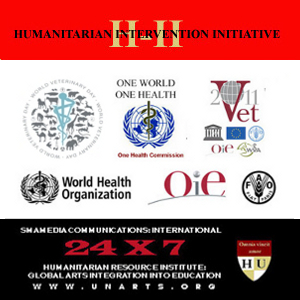.
Notice of Consent: H-II OPSEC
This
is a Humanitarian Intervention Initiative Network. This computer
system, including all related equipment, networks, and network devices
(specifically including Internet access) may be monitored for all
lawful purposes, including to facilitate protection against
unauthorized access, and to verify security procedures, survivability,
and operational security. During monitoring, information may be
examined, recorded, copied and used for authorized purposes. All
information, including personal information, placed or sent over this
system may be monitored. Use of Humanitarian Intervention Initiative
Network, authorized or unauthorized, constitutes consent to monitoring
of this system. Use of this system constitutes consent to
monitoring for these purposes. |
Contact:
Stephen M. Apatow
Founder,
Director of Research & Development
Humanitarian
Resource Institute (UN:NGO:DESA)
Humanitarian University
Consortium Graduate Studies
Center
for Medicine, Veterinary Medicine & Law
Phone:
203-668-0282
Email:
s.m.apatow@humanitarian.net
Internet:
www.humanitarian.net
H-II
OPSEC
Url:
www.H-II.org
Pathobiologics
International
Internet:
www.pathobiologics.org
1 October 2014
Ebola Outbreak 2014
One finding of this is that the 2014 SEQUENCES FALL AS A DIVERGENT
LINEAGE OUTSIDE THE ZAIRE LINEAGE suggesting that this MAY BE a
pre-existing endemic virus in West Africa rather than the result of
spread of the EBOV lineage from the Central African countries that have
had previous human outbreaks. -- Phylogenetic
analysis of Guinea 2014 EBOV ebolavirus outbreak: Epidemic, 17
April 2014.
7 September 2013
6 July 2013
The Johns Hopkins
University Applied Physics
Laboratory (APL) and the Armed Forces Health Surveillance Center
(AFHSC) have released the Suite for Automated
Global Electronic
bioSurveillance (SAGES), a
collection of flexible, open-source
software products developed for electronic disease surveillance in all
settings. -- Johns Hopkins APL Releases Open-Source Electronic
Disease Surveillance Software: JHAPL, 1 July 2013.
17 June 2013
9 November 2012
Optimization of global surveillance (MEDCAP, VETCAP)
for CBRN, Infectious Disease Threats (genomic analysis, evolutionary
tracking of high consequence pathogens).
Biodetection:
Including Mutiplex Microarray:
Related:
-----------------------------------------------
7 November 2012
 DNA
Biometrics - Biological Countermeasure Programs
DNA
Biometrics - Biological Countermeasure Programs
Biometrics has been
added to Exploitation
Analysis
capabilities through H-II: OPSEC. [1] This
field includes DNA Biometrics [2] and Biological
Countermeasure Programs [3] associated with bioinformatics,
[4] typing methods, validation and standardization for high consequence
pathogens.
Humanitarian
Resource Institute [5] mediated extensive background and policy
discussions associated with Bioinformatics:
Pathological Diagnostics, during the 2001 UK FMD and SARS crisis periods.
[6] In 2006, HRI presented the keynote on DNA
Based Detection Technologies [7] at the Los Alamos
Future
of
Biodetection Systems Conference for the intelligence
community. [8]
References:
- H-II
OPSEC: HRI Humanitarian Intervention Initiative. Url:
www.H-II.org
- DNA
Biometrics: Biomolecular Measurement
Division, Applied Genetics
Group, NIST. Url: www.nist.gov/mml/bmd/genetics/dna_biometrics.cfm
- Biological
Countermeasure Programs: Michael
P. McLoughlin: Technologies for
Critical Incident Preparedness.Atlanta, Georgia, September 6, 2006.
Url: www.hsdl.org/?view&did=477544
- Bioinformatics:
Pathological Diagnostics: HRI: Pathobiologics
International. Url: www.humanitarian.net/biodefense/bioinformatics/
- Pathobiologics
International - The Consulting Arm of Humanitarian Resource Institute
and the Humanitarian University Consortium: HRI: Pathobiologics
International, 4 June 2004. Url: www.pathobiologics.org/groundzero.html
- Biodefense Threat Analysis
& Communications Center: Pathobiologics International.
Url: humanitarian.net/biodefense/bioinformatics/
- DNA-based
Detection Technologies (Powerpoint):
Stephen M.Apatow, Humanitarian
University Consortium Graduate Studies Center
for Medicine, Veterinary Medicine and Law. Url:
www.pathobiologics.org/btac/lanl/bioscience/ref/SMABDS_Final.pdf
- Future of
Biodetection Systems: Los Alamos National Laboratories, September,
2006. Url: www.lanl.gov/bioscience/biodetection.shtml
###
|
Back to H-II OPSEC
Copyright © 2012 Humanitarian Resource Institute.
All rights reserved.
|